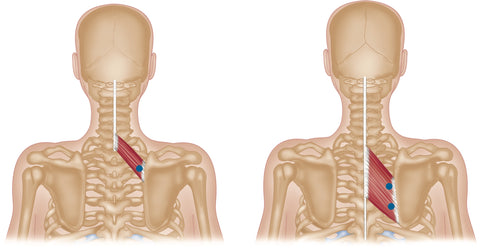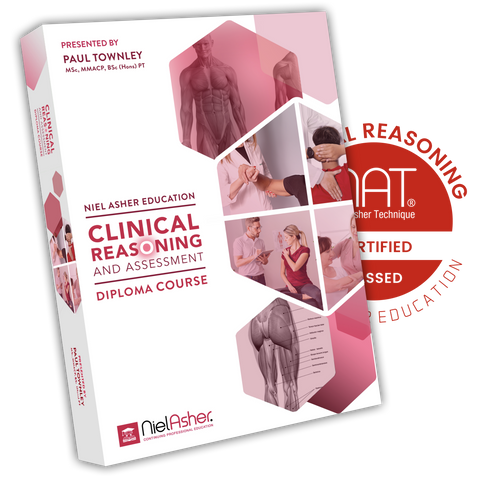Trigger Point Release | Shoulder Pain | Rhomboids

Trigger points in the Rhomboid muscles will typically cause pain around the scapula and in the area between the scapula and the spine
Assessing Scapula Pain and Treating Trigger Points in the Rhomboids - Paul Townley
Trigger Points in the Rhomboids are often associated with chronic poor posture
[Greek rhomboiedes, parallelogram- shaped with oblique angles (and only the opposite sides equal); Latin minor, smaller; major, larger]
Generally referred to as the rhomboids, these are actually two muscles (major and minor).
The rhomboid minor is smaller than the major and sits immediately above the rhomboid major. Both of the rhomboid muscles originate along the thoracic spine with their fibers running diagonally downward and outward to attach along the inside border of the scapula.
Treating Trigger Points in the Rhomboid Muscles - Dr. Jonathan Kuttner
Active trigger points in the rhomboids tend to refer pain to the local area, so will usually present as pain described by the client as mid-upper-back pain, or pain at the back of the shoulder.
Whilst trigger points in the rhomboids are pretty easy to identify and treat, we need to be aware that there is usually more work to be done!
In many cases, trigger points in other muscles such the pecs, or serratus anterior may be causing those muscles to become less efficient, with a resulting effect on the rhomboids.
This is a particularly common scenario with badminton and tennis players.
A detailed examination of the clients posture is extremely important when treating the rhomboids, as well as an understanding of the clients lifestyle including their work, exercise, sleep patterns, and general health.

Rhomboid Trigger Points - Common Referred Pain Pattern
ORIGIN
Spinous processes of 7th cervical vertebra and upper five thoracic vertebrae (C7–T1).
INSERTION
Medial (vertebral) border of scapula.
ACTION
Retracts (adducts) scapula. Stabilizes scapula. Slightly assists in outer range of adduction of arm (i.e. from arm overhead to arm at shoulder level).
Antagonist: serratus anterior.
NERVE
Dorsal scapular nerve, C4, 5.
BASIC FUNCTIONAL MOVEMENT
Example: pulling something toward you, such as opening a drawer.
TRIGGER POINT REFERRED PAIN PATTERNS
Medial border of scapula, wrapping around superior aspect of spine of scapula toward acromion process.

Rhomboid Minor (left) and Major (right) - Common Trigger Point Sites
Trigger Points and the Rhomboids
The rhomboid muscles inevitably develop trigger points, usually as a result of aging, and almost always as a result of postural issues.
The rhomboids are busy muscles, as they work almost constantly to retract the scapula, stabilize the scapula, and also assist in the outer range of adduction of the arm (ex. movement of arm overhead, to arm at shoulder level).
Trigger points may develop as a result of years of chronic poor posture (rounded shoulders), but also as a result of inefficiencies in other related muscles (including trigger points in the pecs, serratus anterior), and injuries from activities such as tennis, or any sport that involves overhead throwing.
Trigger Point Therapy
As described above, trigger points in the rhomboids are relatively easy to locate and treat, but the treatment may be more complex and require more time where the trigger points are caused by other issues that need to be addressed.
Advice to Client and Self Help
Posture. Tight pectorals. Round shoulders. Occupational posture. Stretching. Self-Massage/Pressure Tools.
The stretch below is pretty effective for helping to relieve pain in the rhomboid muscles, and may help to dissipate trigger points when applied regularly between treatments.

Technique
Stand with your knees bent. Cross your arms over and grab the back of your knees. Then start to rise upwards until you feel tension in your upper back and shoulders.
Muscles being stretched
Primary muscles: Trapezius. Rhomboids. Latissimusdorsi.
Secondary muscle: Teres minor.
Injury where stretch may also be useful
Dislocation. Subluxation. Acromioclavicular separation. Sternoclavicular separation. Impingement syndrome. Rotator cuff tendonitis. Shoulder bursitis. Frozen shoulder (adhesive capsulitis).
Additional information for performing this stretch correctly
Keep your shoulders level to the ground and avoid twisting or turning to one side. Always start slowly and stop if you experience pain. Always use your common sense!

Rhomboid Trigger Points - Self-help can be effective
Self Massage and Pressure Tools
Trigger Points in the Rhomboids are generally accessible but obviously being at the back, they generally require a partner.
These trigger points can be quite tough to work and may require sustained pressure. Self help is typically more effective when pressure tools are used.
Where no partner is available, tools like the Backnobber are extremely useful and effective.
Links
More Articles About Shoulder Injuries
More Articles About Trigger Points
Certify as a Trigger Point Therapist

Trigger Point Therapy Diploma Course


Clinical Reasoning and Assessment for Manual Therapists
JOIN NOW
EDUCATION MEMBERSHIP PLANS
UNLIMITED ACCESS
FROM $19.95/monthly
This trigger point therapy blog is intended to be used for information purposes only and is not intended to be used for medical diagnosis or treatment or to substitute for a medical diagnosis and/or treatment rendered or prescribed by a physician or competent healthcare professional. This information is designed as educational material, but should not be taken as a recommendation for treatment of any particular person or patient. Always consult your physician if you think you need treatment or if you feel unwell.
About Niel Asher Education
Niel Asher Education (NAT Global Campus) is a globally recognised provider of high-quality professional learning for hands-on health and movement practitioners. Through an extensive catalogue of expert-led online courses, NAT delivers continuing education for massage therapists, supporting both newly qualified and highly experienced professionals with practical, clinically relevant training designed for real-world practice.
Beyond massage therapy, Niel Asher Education offers comprehensive continuing education for physical therapists, continuing education for athletic trainers, continuing education for chiropractors, and continuing education for rehabilitation professionals working across a wide range of clinical, sports, and wellness environments. Courses span manual therapy, movement, rehabilitation, pain management, integrative therapies, and practitioner self-care, with content presented by respected educators and clinicians from around the world.
Known for its high production values and practitioner-focused approach, Niel Asher Education emphasises clarity, practical application, and professional integrity. Its online learning model allows practitioners to study at their own pace while earning recognised certificates and maintaining ongoing professional development requirements, making continuing education accessible regardless of location or schedule.
Through partnerships with leading educational platforms and organisations worldwide, Niel Asher Education continues to expand access to trusted, high-quality continuing education for massage therapists, continuing education for physical therapists, continuing education for athletic trainers, continuing education for chiropractors, and continuing education for rehabilitation professionals, supporting lifelong learning and professional excellence across the global therapy community.

Continuing Professional Education
Looking for Massage Therapy CEUs, PT and ATC continuing education, chiropractic CE, or advanced manual therapy training? Explore our evidence-based online courses designed for hands-on professionals.


















